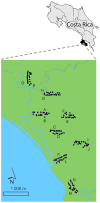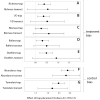The importance of microhabitat for biodiversity sampling
- PMID: 25469770
- PMCID: PMC4254948
- DOI: 10.1371/journal.pone.0114015
The importance of microhabitat for biodiversity sampling
Abstract
Responses to microhabitat are often neglected when ecologists sample animal indicator groups. Microhabitats may be particularly influential in non-passive biodiversity sampling methods, such as baited traps or light traps, and for certain taxonomic groups which respond to fine scale environmental variation, such as insects. Here we test the effects of microhabitat on measures of species diversity, guild structure and biomass of dung beetles, a widely used ecological indicator taxon. We demonstrate that choice of trap placement influences dung beetle functional guild structure and species diversity. We found that locally measured environmental variables were unable to fully explain trap-based differences in species diversity metrics or microhabitat specialism of functional guilds. To compare the effects of habitat degradation on biodiversity across multiple sites, sampling protocols must be standardized and scale-relevant. Our work highlights the importance of considering microhabitat scale responses of indicator taxa and designing robust sampling protocols which account for variation in microhabitats during trap placement. We suggest that this can be achieved either through standardization of microhabitat or through better efforts to record relevant environmental variables that can be incorporated into analyses to account for microhabitat effects. This is especially important when rapidly assessing the consequences of human activity on biodiversity loss and associated ecosystem function and services.
Conflict of interest statement
Figures




References
-
- Cardoso P, Erwin TL, Borges PAV, New TR (2011) The seven impediments in invertebrate conservation and how to overcome them. Biol Conserv 144:2647–2655.
-
- May RM, Harvey PH (2009) Species Uncertainties. Science 323:2009. - PubMed
-
- Willis KJ, Whittaker RJ (2002) Ecology. Species diversity–scale matters. Science 295:1245–1248. - PubMed
-
- González-Megías A, María Gómez J, Sánchez-Piñero F (2007) Diversity-habitat heterogeneity relationship at different spatial and temporal scales. Ecography (Cop) 30:31–41.
Publication types
MeSH terms
LinkOut - more resources
Full Text Sources
Other Literature Sources

